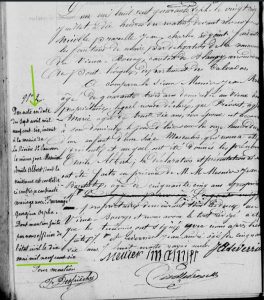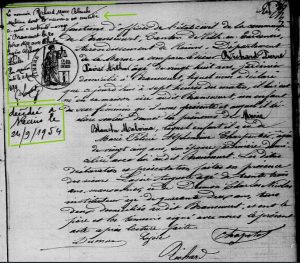The beauty of an individual’s parish or civil records of birth/baptism in France, is that it can also contain written notes of vital genealogical information in the margin area.. Professional French Genealogist Sophie Boudarel of “MyFrenchAncestor” informs us they are called ‘marginal annotations’ .
Let’s examine them:
What are ‘marginal annotations? Sophie Boudarel states “….Marginal annotations are a measure of publicity intended to establish a relationship between two acts of civil status or between an act and the transcription of another act or judgment….”
Here’s what you could find in the marginal annotations:
- the date and place of death
- date, place of marriage with the name of spouse(s),
- Corrections, mostly inaccurate names initially recorded
Depending on the town and Department you’re looking in, you could possibly find a birth record with the margin info as early as 1847, (as shown on the right..click to expand ), as I did. If you look at parish records of Rheims in Marne, you might marginal annotations as well.

This is a civil birth record of Emile Albert Mesnier born 25 July 1847 in Vieux-Bourg, Calvados. In the left margin, you can see the additional notations . Birth documents only mention the marriage and death details of date, place and spouses names. We now know the place and date of this marriage contract of Emile Albert Mesnier and his new bride, Georgina Orpha Fournage, that took place in La Rivière St Sauver, 1906. As you can see, the margin information is very clear and legible. So, now you know where to find the the marriage contract.
But is that margin info correct? As with all genealogical information, you have to provide proof to back up what is written down. In order to prove it, you have to search for the original records of marriage and death at the places the margin annotations makes note of. (This is especially true for genealogical online indexes. Oh, the horrors). This makes the annotations so valuable, as they point you to the right town(s) for research!
Why doesn’t all birth records carry margin info? I certainly wish they would. My humble answer, is, by way of observations and deductions, Town hall civil records officials, by oversite (or can I say they didn’t do their job?), did not report those vital information to the town of birth.
With that being said, very few towns, very few birth records contain margin facts for early 19th century birth records. It just wasn’t the norm. Most likely, you might find a birth record with the ‘annotation in the margin’, but out of a swath of early years from a French Department, maybe just one town will contain the . Yet, some towns, as with Branscourt in Marne, have multiple birth records with margin info through the decades of 1850 & 1860. As each decade progresses, you’ll find more birth records with margin annotations with both marriage (if there was one) and death details.

This 1874 birth document comes from the town of Branscourt (Marne). This particular sample has specific margin information of a marriage AND also of the death details. These are valuable genealogical gleanings directing you to the specific towns and years for finding and proving information from the original records.
Please understand that not all late 1800s and early 1900s birth records have the margin annotations . I know it’s aggravating to come across a birth document of your ancestor only to find it has no margin info provided to help you find your ancestor(s). Such as life in the genealogy world. But we carry on!
Yes, there are Parish baptismal records with margin notations of important genealogical information. This pre-revolution baptism record is dated 30 Oct 1781 from the parish of St Denis, in Rheims (Marne) It’s of an illegitimate male infant, Pierre Simon. For reasons unknown, the mother’s last name was omitted from the baby’s christened name to the side of the document. Was that because the baby was born out of wed-lock? Was it at the mother’s request? Puzzling.
You do see the mother’s name in document is Catherine Lefebvre. No mention of father of the child. What you can see in the margin, is a note of a marriage that took place on 26 or 28 .March 1872 in the parish of St Hilaire in Rheims (Marne). Mostly likely the father married Catherine to make the child legitimate. (This is out of my family tree, and the marriage that took place was complicated)

I use to skim over margin notes as if they were really nothing of value. How wrong I was. They are gateways to genealogical breakthroughs.